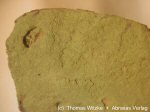|
| Home | Crystal | jmol | jPOWD | Chem | X Ray | Dana | Strunz | Properties | A to Z | Images | Share | News | Help | About |
General Bunsenite Information
Bunsenite Image

|
Comments: Greenish earthy bunsenite. |
Bunsenite Crystallography
Mouse
drag1 - LMB Manipulate Structure
drag2 - RMB Resize/Rotate
Keyboard
S - Stereo Pair on/off
H - Help Screen
I - Data Info
A - Atoms On/Off
P - Polyhedra On/Off
B - Bonds On/Off
Help on Above
|
Physical Properties of Bunsenite
Optical Properties of Bunsenite
CI calc= -0.026 (Excellent) - where the CI = (1-KPDcalc/KC)
KPDcalc= 0.1806,KPDmeas= 0.1864,KC= 0.176
Ncalc = 2.13 - 2.2
Calculated Properties of Bunsenite
note: Specific Gravity of Bunsenite =6.81 gm/cc.
Boson Index = 0.9910177788
U=PEBunsenite x rElectron Density= 207.56 barns/cc.
Bunsenite is Not Radioactive
Bunsenite Classification
Other Bunsenite Information
1 - Am. Min. Crystal Structure Database
2 - Athena
3 - EUROmin Project
4 - Ecole des Mines de Paris
5 - GeoScienceWorld
6 - Google Images
7 - Google Scholar
8 - Handbook of Mineralogy (MinSocAm)
9 - Handbook of Mineralogy (UofA)
10 - MinDAT
11 - Mineralienatlas (Deutsch)
12 - Online Mineral Museum
13 - QUT Mineral Atlas
14 - Ruff.Info
15 - University of Colorado - Mineral Structure Data
16 - WWW-MINCRYST
Search for Bunsenite using:
Visit our Advertisers for Bunsenite :
A Bijoux Google Search for BunseniteAdam's Minerals Google Search for Bunsenite
Cape Minerals Google Search for Bunsenite
Dakota Matrix Minerals Google Search for Bunsenite
Excalibur Mineral Corp. Google Search for Bunsenite
Exceptional Minerals Google Search for Bunsenite
John Betts Fine Minerals Search for Bunsenite
McDougall Minerals Google Search for Bunsenite
Mineral News Website Link
Rock and Mineral Shows Google Search for Bunsenite
Weinrich Minerals, Inc. Google Search for Bunsenite
Ask about Bunsenite here :
Ask-A-Mineralogist from the Mineralogical Society of America
Mindat.org's Discussion Groups
Original Rockhounds Discussion Group
Rockhounds Discussion Group on Yahoo Groups
Mineral Discussion Forum from Fabre Minerals - also available in
Espaņol
Print or Cut-and-Paste your Bunsenite Specimen Label here :
|
Bunsenite NiODana No: 04.02.01.02 Strunz No: 04.AB.25 Locality:
Notes:
|
